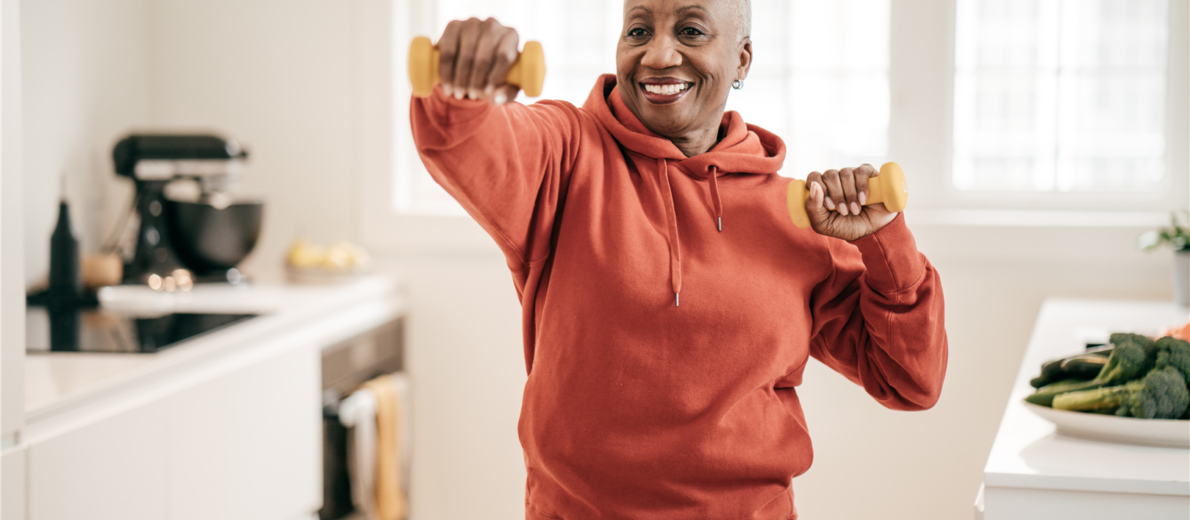Beginner Exercise Tips for Seniors

If you’re new to exercise (or it’s just been awhile), you might have a lot of questions about how to get started. But exercise doesn’t have to be complicated, nor does it need to be exclusive to age or certain health conditions. Exercise can be a simple few minutes of movement that are a part of your daily life. Whether you’re getting started or getting back into it, use these exercise tips for seniors to build up your routine—and your health.
Talk with your doctor about your safest options
There are many gentle exercises most people can start right away, but certain health conditions and medications can both determine and affect levels of physical activity. Set up a short appointment with your doctor to go over what exercises are safe and recommended for you.
Keep it simple: just move every day
“The most important thing is movement every day,” says Julia Goldie, Life Enrichment Director at Era Living’s Aljoya Thornton Place and a Certified Personal Trainer. “Whether it’s walking instead of driving or chasing after your grandkids, you can get exercise from regular movement in life.”
Exercise not limited to the structured and sweaty regimes that we see in gyms and classes today. Adding movement into your daily life is the most important part of keeping yourself healthy. And, it can be on your terms. Thirty minutes can be a mashup of walking, yoga, strength training, stretching, and light weights. You can also space it out and take three 10-minute walks, stair climbs, or balance sessions for that day. And if weather or physical distancing prevent you from walking outside, Julia recommends the YouTube City Walks channel as a fun way to help get in your steps indoors.
Always include strength training, balance, and stretching
Strength training, balance work, and stretching are critical to staying healthy and reducing fall risk. For older adults, this is especially true since we experience increased muscle loss as we age. Light hand weights can be a big part of strength training, but they’re not always necessary. We can use body weight to build strength in the muscles and spine in inclined wall pushups, floor pushups on knees, bridges, and bird dog poses.
Household objects can also be great substitutes for hand weights. Canned goods, like 16- or 32-ounce cans, can easily work for bicep curls, tricep presses, and shoulder raises. When held in a suspended pose, even these light cans can start to feel more challenging than they first appear.
Balance is determined and affected by sensory feedback from our vision, hearing, and joints. It is also impacted by conditions that would cause dizziness or depth perception issues. As our senses can decrease with age, building up the stabilizing muscles in the core and legs becomes even more important. Include balance exercises in your workout like marching slowly in place, standing on one foot, and even standing with your eyes closed.
Stretching can often seem like an afterthought, but it’s actually as much a part of exercise as active movement. Unstretched muscles can shorten and tighten, limiting and decreasing movement. By increasing flexibility over time with a gentle stretch routine, we can improve range of motion and blood circulation while decreasing load on the muscle itself. Try some simple stretches for upper body and legs—and don’t forget to breathe slowly and deeply.
Start with functional exercises
Think about the movements that you need to do every day, like standing, reaching, bending, lifting, and taking stairs. Building your workout around these movements, like including safe-form squats and lunges and balance work, can help you feel stronger and move more easily—even just around the kitchen.
Ask for help on safe form
Even professional athletes benefit from a personal trainer checking on their form. Many personal trainers are working online through Zoom and will be able to direct you to place your camera so that they can see how you move and use weights. They’ll be able to suggest corrections and help you exercise as safely as possible, and even one session might give you all the information you need to protect yourself from injury.
Give yourself support
We can get the best exercise when we feel good in our bodies to begin with. Setting ourselves up for success includes drinking plenty of water to stay hydrated, eating healthy foods, stretching, and getting quality sleep.
We can also seek outside support from friends and family. Feeling connected, supported, and in solidarity with others can help us stay more motivated to stick with exercise. Ask a friend or family member to help keep you accountable either with check-ins or by joining you, whether in a class or in their own exercise program.
Modify for your body
Yes, there is gain without pain, says Julia. Many people still believe exercise has to hurt—this is not only wrong, but also can be harmful. There’s a big difference between a challenging exercise and feeling actual pain or joint stress. Give yourself permission to be gentle as needed. Additionally, avoid exercise that would aggravate a joint issue, cause dizziness, or interfere with injury recovery. Make the exercise fit you, not the other way around.
Additional Exercise Tips for Seniors
Need extra motivation? Try these tips from Julia Goldie, Life Enrichment Director and fitness instructor at Era Living Aljoya Thornton Place.
Find an exercise or movement you love
Building new habits is enough of a challenge. Trying to stick with something you dread is adding an unnecessary hurdle to exercise. Adhering to a health plan can be difficult. Many people force themselves to stick to a plan by signing up for monthly vitamin subscriptions, paying for a gym membership in advance, or buying expensive home exercise equipment. When it’s movement that makes you feel good, it’s much easier to make it a part of your life.
Pick your most energetic time of the day
This might be first thing in the morning, right before lunch, or mid-afternoon. Exercising while tired can increase your risk of injuring yourself, and it’s much harder to approach the idea of exercise if you feel sleepy or tired. Being able to approach exercise with energy sets you up for success—and being able to build the habit can raise your baseline energy levels as well.
Have music ready to help you move
Some people exercise without listening to anything (like in Tai chi), but sometimes even they need an energy boost. Have a few mood-boosting songs or music collections ready to turn on to help you get in the mindset and get on your feet.
Take advantage of your devices
If you enjoy using fitness apps or websites, there’s a whole world of online classes and guided workouts to do on your own or with others. Silver Sneakers offers online classes and workshops (free through select Medicare plans), and many personal trainers are providing virtual sessions and classes. And membership apps like Down Dog customizes your yoga session, while Pilates Anytime offers Pilates instruction and education videos for all levels.
It’s never too late to start getting into exercise! If you’re interested in learning more about how to stay fit and health as an older adult, or about how Era Living helps keep our residents active, please contact us today.
Related Posts

Podcast: A Day in the Life at Era Living – Resident Diane Miller

Podcast: Advocating for Retirees in Senior Living

